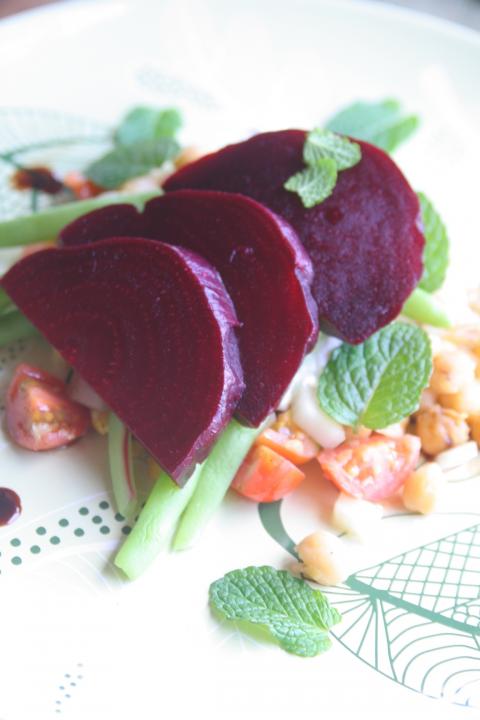Beetroot is not a vegetable common either in traditional markets or in Taiwanese cuisine generally, but its relative ease of cultivation has made it popular with amateur farmers, and its numerous health benefits has given it great cachet with the health food crowd. My own memories of beetroot are of slices of sickly canned pickled beetroot bleeding into stogy vegetable sandwiches, a recollection that led me to relegate this incredibly tasty root vegetable to a culinary outer darkness. The experience of roasted whole beets when dining with a Greek family in Australia, and the discovery of its easy availability from small local farmers in Taiwan (generally organic or at least pesticide free) launched me into a passionate exploration of ways to incorporate it into my cooking.
Until recently, I had generally believed that only the root of the beet could be eaten, and in most markets, beets are sold without their leaves. If you are lucky enough to find beets with leaves intact, you should take care to use them as they are a rich source of nutrition and make for very good eating. The reason that leaves are usually removed prior to sale seems to be that they wilt very quickly and are cut off to facilitate packaging and presentation. Beets with firm leaves attached are a guarantee of freshness.
If you get whole beets with leaves, you need to cut the leaves off about 5cm to 10cm above the root (thus keeping the root intact) and par-boil as soon as possible, after which they can be kept for two or three days. I usually fry the greens with a bit of garlic and olive oil, and they can be served just as they are with rice or used in recipes that call for spinach.

Photo: Ian Bartholomew
Beetroot and their greens have a long history as a use in medicine. The leaves are rich in calcium, iron and vitamins A and C, and the vegetable as a whole is a good source of dietary fiber, manganese and potassium. Beetroot is credited with being particularly helpful as a means of treating disorders of the liver and for detoxification (making them particularly suitable for the Christmas to Lunar New Year festive season). They are excellent for regulating bowel function and are one of the richest sources of glutamine, an amino acid that helps promote the health of the intestinal tract.
While thinly sliced beetroot can be served raw in salads (be aware that the raw juice can stain both skin and kitchen furnishings), beetroot’s amazing flavor is best served, to my mind, by boiling in slightly salted water. Do not peel the beetroot and leave a short amount of the stem, effectively sealing the flesh and retaining the maximum amount of goodness while cooking. Once cooked, I find that the beetroot stores best in the fridge unpeeled, and only remove the skin when ready to use.
Beetroot has an earthy flavor that some people may find unpleasant on its own. There is considerable discussion about how to remove this taste on Chinese-language Web sites, but personally I find that this earthiness, if balanced with other vegetables or with meats, is really the main attraction. For those who love it, its hard to get too much beetroot, and the Love Beetroot Web site (www.lovebeetroot.co.uk) is a great place to find other ideas of what to do with this sphere of red goodness.
Boiled beetroot with chickpea salad and yogurt (serves 2)
Ingredients
2 medium beetroots
30g dried chickpeas (soaked overnight)
3 cloves garlic
1/2 cup vegetable stock (preferably homemade)
8 cherry tomatoes, roughly chopped
1/2 small onion, finely diced
6 broccoli shoots or French beans
Small bunch mint leaves
2 teaspoons balsamic vinegar
Unsweetened thick plain yogurt (preferably homemade)
Olive oil
Salt and pepper
Directions
1. Wash the beetroots; place them in a pot and cover with lightly salted cold water. Bring to a boil and then reduce heat and simmer until a skewer can pierce the root with ease (about 40 minutes to an hour depending on the size of the beetroot). Set aside.
2. Clean the broccoli shoots and peel the tough outside skin (if necessary). Place in a steamer over high heat for 4 minutes. Remove from heat and transfer shoots to ice water to stop the cooking process.
3. Drain the chickpeas and cover with fresh water. Cover by about 5cm with water (do not add salt), bring to a boil and then keep at a high simmer until tender but not mushy (about 30 minutes). Strain, season lightly with salt and set aside.
4. Put a generous glug of olive oil into a pan and warm over low heat. Add minced garlic and cook until fragrant but do not allow to color. Add chickpeas and cook for 2 minutes. Add stock and cook for another 5 minutes until the stock is slightly reduced.
5. Now you can put the dish together.
6. Transfer the chickpeas to a bowl and add the chopped cherry tomatoes and onion (if you find raw onion too sharp, you can either add a little salt after dicing or dip them into boiling water for a few seconds). Add the balsamic vinegar, season with salt and pepper and mix. Place on a plate.
7. Add the broccoli shoots or French beans. Top with a good dollop of yogurt. Sprinkle with mint leaves. Peel and slice the beatroot and place on top.
Ian Bartholomew runs Ian’s Table, a small guesthouse in Hualien. He has lived in Taiwan for many years writing about the food scene and has decided that until you look at farming, you know nothing about the food you eat. He can be contacted at Hualien202@gmail.com.

No one saw it coming. Everyone — including the Chinese Nationalist Party (KMT) — expected at least some of the recall campaigns against 24 of its lawmakers and Hsinchu Mayor Ann Kao (高虹安) to succeed. Underground gamblers reportedly expected between five and eight lawmakers to lose their jobs. All of this analysis made sense, but contained a fatal flaw. The record of the recall campaigns, the collapse of the KMT-led recalls, and polling data all pointed to enthusiastic high turnout in support of the recall campaigns, and that those against the recalls were unenthusiastic and far less likely to vote. That

Behind a car repair business on a nondescript Thai street are the cherished pets of a rising TikTok animal influencer: two lions and a 200-kilogram lion-tiger hybrid called “Big George.” Lion ownership is legal in Thailand, and Tharnuwarht Plengkemratch is an enthusiastic advocate, posting updates on his feline companions to nearly three million followers. “They’re playful and affectionate, just like dogs or cats,” he said from inside their cage complex at his home in the northern city of Chiang Mai. Thailand’s captive lion population has exploded in recent years, with nearly 500 registered in zoos, breeding farms, petting cafes and homes. Experts warn the

A couple of weeks ago the parties aligned with the People’s Republic of China (PRC), the Chinese Nationalist Party (KMT) and the Taiwan People’s Party (TPP), voted in the legislature to eliminate the subsidy that enables Taiwan Power Co (Taipower) to keep up with its burgeoning debt, and instead pay for universal cash handouts worth NT$10,000. The subsidy would have been NT$100 billion, while the cash handout had a budget of NT$235 billion. The bill mandates that the cash payments must be completed by Oct. 31 of this year. The changes were part of the overall NT$545 billion budget approved

The unexpected collapse of the recall campaigns is being viewed through many lenses, most of them skewed and self-absorbed. The international media unsurprisingly focuses on what they perceive as the message that Taiwanese voters were sending in the failure of the mass recall, especially to China, the US and to friendly Western nations. This made some sense prior to early last month. One of the main arguments used by recall campaigners for recalling Chinese Nationalist Party (KMT) lawmakers was that they were too pro-China, and by extension not to be trusted with defending the nation. Also by extension, that argument could be